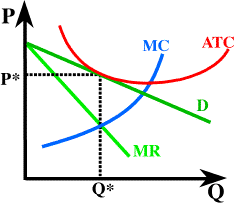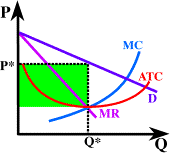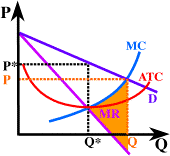A question such as this can almost be thought of as definitional.
Just remember what you know about long run equilibrium in monopolistic
competition with free entry and you're there.

Remember that free entry means that profits will be zero, which
means that Price = Average Total Cost. This eliminates all but d. and e. right away. Since the firm
faces a downward sloping demand curve and we have no reason to
think it is a perfect price discriminator Marginal Revenue must be less than Price and since MR = MC, MC must be below price, answer e. Take a look at the graph to the
left, showing a monopolistically competitive firm in long run
equilibrium as a reminder.
3. Which of the following describes long run equilibrium for a
firm in monopolistic competition with free entry?
- Marginal Revenue = Average Total Cost, Price > Marginal Cost.
If Marginal Revenue = Average Total Cost the firm would be earning
a large profit and so, with free entry, could not possibly be
in long run equilibrium. The graph below illustrates this.

- Price > Average Total Cost, Price = Marginal Cost. As above if Price > Average Total Cost the firm is earning a profit
and can't be in long run equilibrium. If the firm operates where
Price = Marginal Cost it isn't maximizing profits. The shaded area in the graph below shows the lost profit due to selling too much
output at too low a price, Price = Marginal Cost.

- Price > Average Total Cost, Marginal Revenue = Marginal Cost.
If Price > Average Total Cost the firm is earning a profit and
can't be in long run equilibrium. The same graph for answer a.
illustrates this as well.

- Price = Average Total Cost, Marginal Revenue > Marginal Cost.
Price = Average Total Cost is consistent with long run equilibrium,
but Marginal Revenue > Marginal Cost means the firm isn't maximizing
profits. If, as shown below, the firm produces where both these
conditions are met (P,Q) it will earn zero profit when it could earn positive profit,
shown by the shaded area below.

- Price = Average Total Cost, Price > Marginal Cost.
Next Question
Copyright © 1995-2004 OnLineTexts.com, Inc. - All Rights Reserved








